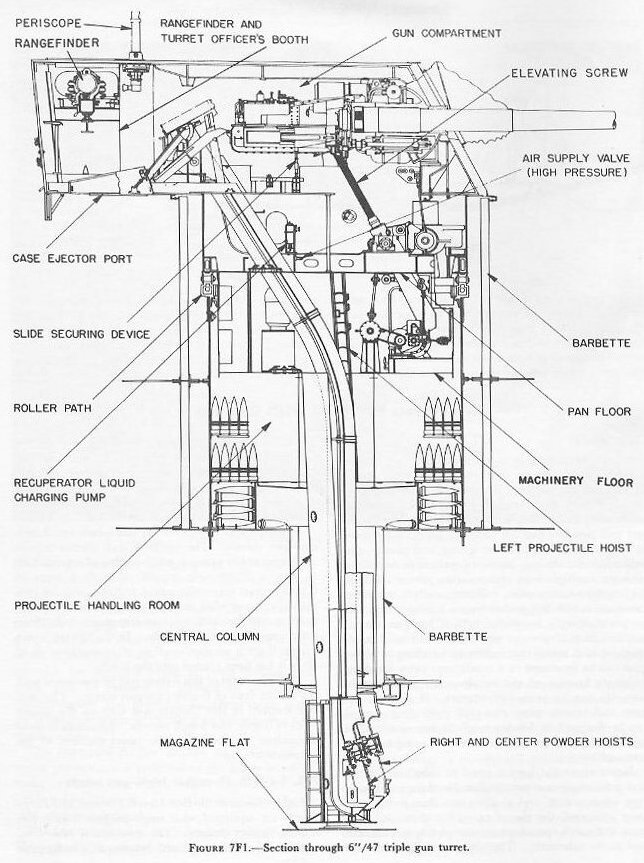| GENE SLOVER'S US NAVY PAGES NAVAL ORDNANCE AND GUNNERY VOLUME 1, NAVAL ORDNANCE CHAPTER 7 TURRET INSTALLATIONS |
| HOME INDEX Chapter 7 Turret Installations A. Introduction B. Gun and breech assembly C. Slide assembly D. Elevating, traning and sight gear E. Ammunition handling F. Turrets equiped with case guns G. 6"/47 dual-purpose gun and turret H. 8"/55 rapid-fire gun and turret |
| G. Turrets Equipped With Case Guns 7F1. General Propelling charges in metal cartridge cases have a number of advantages over charges in fabric bags. Metal cases are mechanically much sturdier than fabric bags; they don’t burn if exposed to a spark or momentary flame; they’re much less likely to rupture and spill powder; and the complete propelling charge in its case, including powder, igniter, and primer, can be loaded into the gun in one operation, as compared with the multiple bags and separate primer required for bag-type ammunition. Consequently a turret for case guns can be designed to have a minimum of compartmentation as compared with a bag-gun turret; manhandling of powder can be reduced to a minimum-which means that automatic handling by power gear can be increased to a maximum; extra handling necessary because of the requirements of flametight integrity can be radically reduced. It follows that guns and turrets using case-type propelling charges can be designed to develop much higher rates of fire, and with smaller crews, than can those using bag-type ammunition. Hence there has been a trend to substitute turrets and guns using case ammunition for those using bag-type ammunition, and at the same time firing rates have increased, the size of crews has decreased, and more and more operations are completely mechanized and made automatic. The ultimate design objective is a turret which, upon signal from a remote station, will train and elevate its guns to a desired position, load its guns, commence firing when the target comes within range, and continue firing until the target is destroyed or all the ammunition expended, all without; assistance from operating personnel. At the present time the Navy has 6-inch and 8-inch case-gun turrets. The earlier 6-inch turrets require in general about as much manhandling of ammunition as does a 5”/38 twin mount. The later types of 6-inch turrets have eliminated manhandling of propelling charges after they have been loaded into the hoist; projectiles still are transferred manually from hoist upper end into gun slide. In the newest 8-inch turrets there is no manhandling of ammunition at all after it has been loaded into the hoists. The remainder of this section will be concerned with the earlier type of 6-inch case-gun turret. The next two sections in this chapter will take up the newest types of 6-inch and 8-inch turrets. Emphasis in these discussions will be upon the novel features of the ordnance design. 7F2. Six-inch 47-caliber triple-gun turrets Light cruisers of the Brooklyn, Cleveland, and Fargo classes are equipped with single-purpose 6-inch turrets of similar designs. The gun has a monobloc, radially expanded barrel with housing and wedge-type sliding breechblock. Ammunition is supplied to the gun room through 1 projectile hoist and 1 powder hoist for each gun, and is transferred by the gun crew from the top of the hoist into a loading tray in the gun slide. Although the maximum elevation of the guns is 60 degrees, loading must be accomplished at an elevation of 22° or less because of the limitations of the ammunition-loading mechanisms and the empty-case ejection system. Gun compartment features generally resemble the smaller semiautomatic guns, such as the 5”/38 caliber which is described in the next chapter. The gun compartment is not divided into separate gun rooms, because the inherently greater safety of case ammunition renders such minute flametight subdivision unnecessary. The rear part of the gun house, as in major-caliber turrets, includes the turret officer’s booth with rangefinder and equipment for local control of fire. The pointer’s and sight checker’s stations are located outboard of the left gun, the trainer’s and sight setter’s stations outboard of the right gun, neither station being separated from the gun compartment by bulkheads. Levels of the turret below the gun compartment serve the same purposes as in the 16”/50 turret described above. They are, as is clearly shown in figure 7F1, somewhat simplified as appropriate to the smaller size and lighter weight of the whole assembly and each of its components. One major simplification is in powder hoist design, the charges for the 6”/47 gun being handled by an endless-chain conveyor-type hoist with open flights instead of powder cars. Elevating and training gear are of electric-hydraulic type and permit a selection of remote or local control. |
 |